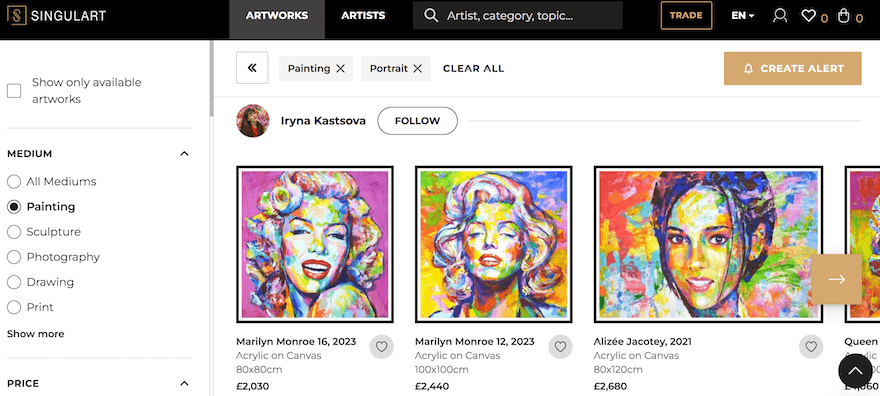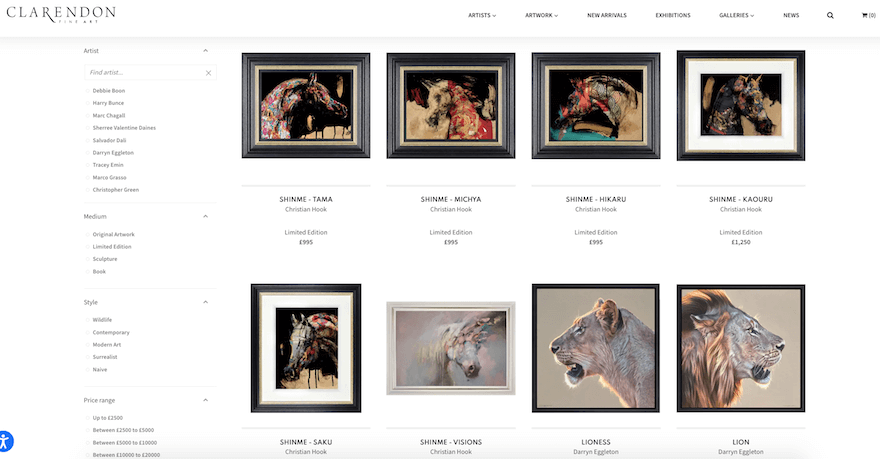Art That Sells: 7 Types of Best-Selling Art
If you click to purchase a product or service based on our independent recommendations and impartial reviews, we may receive a commission. Learn more
Looking to start selling art online – but not quite sure which type of art you want to deal in?
It’s a common conundrum – especially when there’s so many beautiful, brilliant forms of art out there. These days, selling online is easy thanks to marketplaces and website builders. But how can you pick and make art that sells?
What are the best selling art forms to fit out your online art store with, which stores are already doing it well – and how can you get started selling art online?
Below, we’re unpacking the top 7 forms of best selling art. From abstract art and pop art to minimalism and still life paintings, these are the art forms that are lucrative – and that can take your online art business to new, increasingly picturesque heights.
1. Abstract Art
Abstract art does away with a traditional focus on representing recognizable objects, or images, from the physical world – and instead emphasizes shapes, colors, and forms.
Abstract artists use color, line, and texture to create compositions that are open to interpretation – so every viewer can read the work in their own way, and extract their own meaning. Abstract art is focused on creating an aesthetic experience: resulting in artwork that’s expressive, stimulating, powerful, and striking.
Some popular abstract artists include:
- Wassily Kandinsky
- Piet Mondrian
- Kazimir Malevich

2. Portrait Paintings
One of the oldest forms of art, portrait paintings tap into one of humanity’s oldest, most established loves… itself!
Portrait paintings depict a person, or group of people – typically focusing on their face, and sometimes their body or clothes. A good portrait painting captures not only likeness of its subject, but character and personality, too – and since ancient times, portraits have been used to celebrate the power, beauty, and importance of individuals throughout history.
Today, portrait painting remains popular across an array of styles and media: from realistic oil paintings to experimental mixed-media works.
Some of the most famous portrait painters include:
- Leonardo da Vinci
- Michelangelo
- Raphael

3. Pop Art
If you’re familiar with Andy Warhol – or, more specifically, his iconic Campbell’s soup can work – you’ve heard of pop art.
Pop art emerged in the 1950s in the UK and US. Characterized by a focus on mass media and popular culture – plus a strong sense of satire and irony – pop art pulls its themes from advertising, consumer goods, and popular entertainment. It’s also known for its reuse and repurposing of imagery taken from ads and comic books, as pop artists sought to subvert the consumerist values of post-war society.
Even now, though, pop art is popular – and its ability to critique and comment on public life and culture mean it’s as relevant, today, as ever.
Some popular pop artists include:
- Andy Warhol
- Roy Lichtenstein
- Claes Oldenburg

4. Wildlife Art
Wildlife art focuses on depicting animals: whether through painting, drawing, sculpture, printmaking, or photography.
Like portrait paintings, wildlife art can be traced back to the very origins of human life: when prehistoric people etched images of the animals they saw around them into cave walls. In a more modern context, wildlife art is a popular way of celebrating the diversity and complexity of the natural world – not to mention its beauty.
Wildlife art is also an excellent way of drawing attention to topical issues around conservation and animal rights – and of inspiring viewers to take action to protect the planet, and its inhabitants.
Some renowned wildlife artists are:
- John James Audubon
- John Gould
- Terry Isaac

5. Minimalist Art
Minimalism emerged in the 1960s as an attempt to create a sense of order, clarity, and objectivity through art.
Minimalist art is characterized by its simplicity. It uses geometric shapes to reduce art to its most essential, fundamental elements – creating works which are stripped back, and free of all unnecessary ornamentation or decoration. Minimalist artists typically limit their color palette to a small amount of basic colors – and, if they’re working in sculpture, favor industrial materials like concrete and steel.
Its modern and simple style can often make minimalist art ideal for the home or workspace, especially those with a very contemporary aesthetic.
Typically, minimalist ideals reject the notion of art as a means of self-expression or individualism. Instead, minimalist artists focus on the viewer’s experience of the artwork – rather than the artwork itself – with an emphasis on the physical, sensory qualities of the work. (Such as its size, weight, or texture.)
Popular minimalist artists include:
- Donald Judd
- Dan Flavin
- Agnes Martin

6. Fan Art
Fan art refers to artwork created by fans of a particular media franchise – such as Spiderman, say, or James Bond. Usually, it’s created as a way for fans to express their love and admiration for a specific movie, TV show, video game, or comic book – but it can also be a lucrative business model, too.
Fan art can take many forms (including drawings, paintings, digital art, sculptures, and cosplay costumes), and draws inspiration from official artwork, promotional materials – and the artist’s own imagination!
There’s no doubt – fan art is art that sells. That said, it does raise some legal and ethical questions about copyright and intellectual property. And, while some franchises embrace fan art (hey, free publicity!), others may take legal action to protect their IP. So, if you decide to go down the route of selling fan art, you’ll need to bear these issues in mind.

7. Still Life Paintings
Still life paintings depict inanimate objects: such as fruit, flowers, food, or household items.
Like portraits and wildlife art, still life artwork has a long history as a way of celebrating the beauty there to be found every day, in the most everyday objects. But it became particularly popular during the Renaissance and Baroque periods, as artists like Caravaggio, Vermeer, and Cezanne propelled the artwork to the peak of its popularity.
More recently, artists such as Damien Hirst and Fernando Botero are driving the trend of still life paintings as a best selling art form – and driving its enduring legacy.
Notable still life artists:
- Paul Gauguin
- Henri Matisse
- Vincent van Gogh

Summary
So – what’ll it be?
A more conceptual art form, like minimalism, abstract, or pop art? Or a style that taps into things we can actually recognize as a people, place, or thing, or see around us on a daily basis – like portrait paintings, wildlife art, or still life?
Whichever art you choose to sell (heck, you might even want to sell all of them!), there’s one thing you need to do first – and that’s set up a website.
To get started, we recommend diving into our guide to the best website builders for artists. In it, we crunch all the numbers – delivering you everything you need to know to get your art-selling online presence off the ground.
And of course, we’d never let you go without some inspiration, first! So before you head off to start building, be sure to check out our guides to some excellent art portfolio examples – and the best artist website templates to construct your site upon.
That’s just about it from us – so good luck, and have fun in your journey to make art that sells!

4 comments